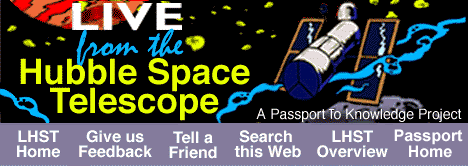


Bill Gutsch helped translate this information from more technical NASA documents.
The Hubble Space Telescope has a variety of scientific instruments. These include two cameras, two devices called spectrographs and additional instruments called fine guidance sensors. Because the HST orbits in outer space above the atmosphere, it can see more clearly than telescopes on the surface of the earth. When astronomers speak about how clearly a telescope sees, they talk about how fine a detail the telescope can see or how close together two objects like stars can be and still be seen as two distinct objects by the telescope.
The moon is about a half of a degree across. Since astronomers divide degrees up into 60 minutes of arc, the moon may also be said to be about 30 minutes of arc across. A circle, as you know, has 360 degrees. Each degree is sub-divided into 60 arc minutes, and each arc minute into 60 arc seconds. The best telescopes on the ground can rarely see detail that is less than 1 second of arc wide (or split two stars that are less that one second of arc apart in the sky) because turbulence in the earth's atmosphere causes the image to ripple and shimmer. By comparison, the HST can see detail down to less than 0.1 seconds of arc across or, in other words, more than 10 times clearer. This is one of the main reasons astronomers like to use the HST.
During the 1993 Servicing Mission, the other instruments on board the HST also got special "eye glasses" to correct for the wrongly shaped main mirror. Together, these special lenses are called COSTAR and they now help HST see with wonderful clarity. The instruments COSTAR helps are:
This camera was developed for NASA by the European Space Agency and can see details better than any other device on board the HST. This camera is also very, very sensitive to light and helps astronomers study some of the most distant galaxies in the universe. Indeed the Faint Object Camera (FOC) must be used with special filters if the HST is pointed at anything less than 200 millions times fainter than the faintest star which can be seen with the unaided eye! The FOC will be used to image pluto during the Live from observations.
A spectrograph is an instrument which takes the light from planets, stars and galaxies and spreads it out into a rainbow or spectrum of colors (just like a prism). From the spectrum of an object, astronomers can determine an amazing amount of information including the object's temperature, what it's made of and whether it's moving toward or away from us and how fast. As its name suggests, the Faint Object Spectrograph can examine very faint objects such as distant or small galaxies. It can examine the visible part of an object's spectrum as well as some of the radiation the object gives off at both ends of the spectrum (infrared and ultraviolet) beyond what the human eye can see.
The pointing of some spacecraft is done using little rockets attached to the spacecraft that gently turn it in different directions. But, that is not the way the Hubble Space Telescope is pointed. The HST is so sensitive and has to work for so many years in space, that scientists use a system of gyroscopes (little devices that look like and spin like toy tops) to measure the rate the HST is moving. Reaction wheels are used to turn the HST. The system applies Newton's laws of action and reaction in a very interesting way. This all happens very slowly. In the process of being re-aimed from one object to the next, the HST turns about as fast as the minute hand on a clock. Other gyroscopes keep the HST pointed steadily at its target just as gyroscopes help keep planes and rockets on course.
The solar panels, along with the FOC, were built by the European Space Agency. The Live From Broadcast on March14 will receive a videoconference uplink from The European Space Agency's facility at Garching, near Munich, Germany.
Information for this description of the Hubble Telescope came from the National Space Science Data Center and the Space Telescope Science Institute.

![]()